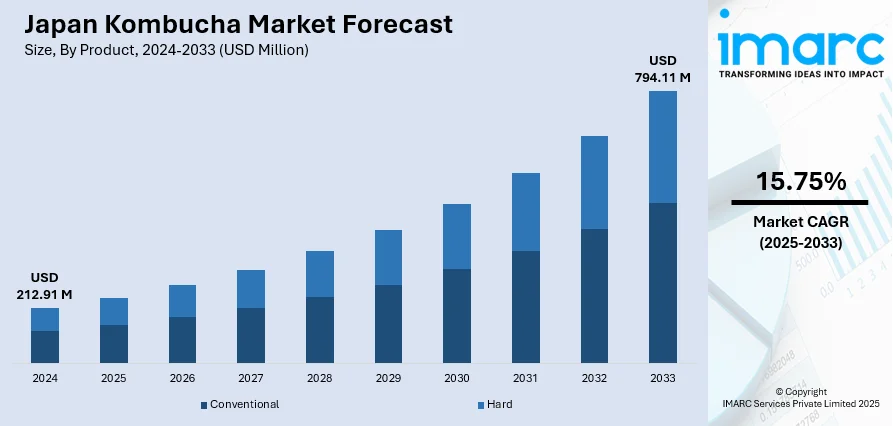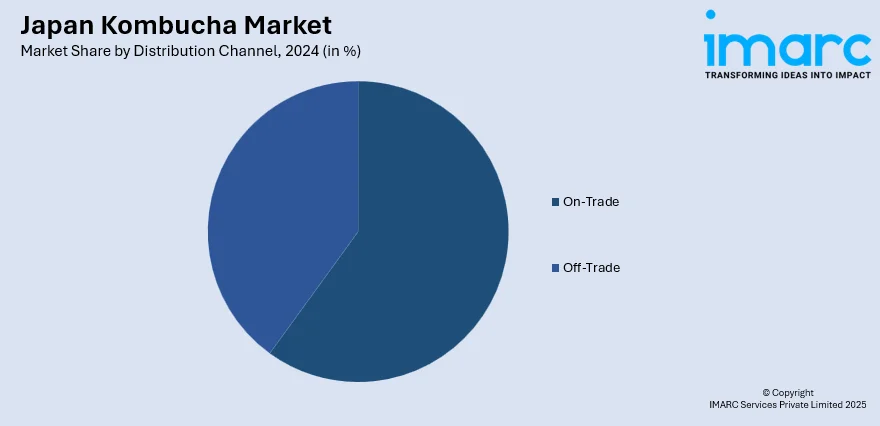
Japan Kombucha Market Size, Share, Trends and Forecast by Product, Distribution Channel, and Region, 2025-2033
Japan Kombucha Market Overview:
The Japan kombucha market size reached USD 212.91 Million in 2024. Looking forward, IMARC Group expects the market to reach USD 794.11 Million by 2033, exhibiting a growth rate (CAGR) of 15.75% during 2025-2033. The market is fueled by the increasing consumer demand for health and wellness products as consumers seek natural drinks that are good for the digestive system and immune system. Enhanced awareness of the probiotic nature of Kombucha has also contributed to its popularity among health-conscious consumers. Also, the growth of functional drinks in Japan and the requirement for specialty flavors are further expanding the Japan kombucha market share.
|
Report Attribute
|
Key Statistics
|
|---|---|
|
Base Year
|
2024
|
|
Forecast Years
|
2025-2033
|
|
Historical Years
|
2019-2024
|
| Market Size in 2024 | USD 212.91 Million |
| Market Forecast in 2033 | USD 794.11 Million |
| Market Growth Rate 2025-2033 | 15.75% |
Japan Kombucha Market Trends:
Growing Demand for Health-Conscious Beverages
The demand for health-focused beverages is increasing in the market as consumers become more aware of the advantages of probiotics and functional drinks. Consumers in Japan are becoming more health-conscious, and many are looking for products that fit their wellness objectives. Products that help improve digestion, build immunity, and optimize gut health are in high requirement. Kombucha, with its natural fermentation mechanism, has healthy probiotics that enhance these health benefits. Therefore, it is an appealing substitute for sugary soft drinks and other synthetic drinks. Apart from this, the increased demand for plant-based and natural foods also supports this trend, as Kombucha falls within the preference for organic, clean-label foods. The heightened health awareness is driving greater demand for Kombucha and other functional beverages, including herb teas, which place a strong emphasis on wellness advantages such as cleansing and general vitality.

To get more information on this market, Request Sample
Expansion of Product Variety and Flavors
The shift toward product diversification, where manufacturers are emphasizing a broader array of flavors and formulations, is significantly contributing to the Japan kombucha market growth. Classic Kombucha, with its tart taste and vinegary flavor, has been modified to suit local tastes by adding yuzu, matcha, and hibiscus flavors. Localization of the flavors has enabled Kombucha to gain more acceptability in Japan. In addition, companies are testing new ingredients like functional herbs, fruits, and spices to come up with innovative and health-enhancing versions. The customization of Kombucha to meet consumer demands for flavor innovation is also driven by the rise of premium, artisanal products. This trend is particularly evident in the increasing popularity of small-batch, craft Kombucha, which allows consumers to enjoy a more personalized and specialized drinking experience, which makes it more appealing to a growing base of adventurous and discerning consumers.
Rising Popularity of Sustainable and Eco-Friendly Products
Sustainability is increasingly becoming a major concern among Japanese consumers, especially in the beverage industry. On March 18, 2025, Japan's Ministry of Economy, Trade, and Industry (METI) released a draft of the Design Standards for PET beverage bottles with the aim of enhancing environmental sustainability. The new rules suggested the prohibition of colored PET bottles, limitation of surface printing, and specifications for the integrated use of not less than 15% recycled or bio-based plastic in production. These guidelines not only indicate the increasing demand from consumers for eco-friendly packaging but also establish new standards for the industry, putting pressure on Kombucha brands to get environmentally friendly packaging. Besides this, some Kombucha brands are emphasizing sustainable sourcing of ingredients, minimizing environmental footprint during production, and using eco-friendly packaging solutions like glass bottles and recyclable materials. This increased interest in sustainability is not just a reaction to consumer demand but also mirrors wider global shifts toward waste reduction and eco-friendly brands.
Japan Kombucha Market Segmentation:
IMARC Group provides an analysis of the key trends in each segment of the market, along with forecasts at the country and regional levels for 2025-2033. Our report has categorized the market based on product and distribution channel.
Product Insights:
- Conventional
- Hard
The report has provided a detailed breakup and analysis of the market based on the product. This includes conventional and hard.
Distribution Channel Insights:

- On-Trade
- Off-Trade
A detailed breakup and analysis of the market based on the distribution channel have also been provided in the report. This includes on-trade and off-trade.
Regional Insights:
- Kanto Region
- Kansai/Kinki Region
- Central/Chubu Region
- Kyushu-Okinawa Region
- Tohoku Region
- Chugoku Region
- Hokkaido Region
- Shikoku Region
The report has also provided a comprehensive analysis of all the major regional markets, which include Kanto Region, Kansai/Kinki Region, Central/Chubu Region, Kyushu-Okinawa Region, Tohoku Region, Chugoku Region, Hokkaido Region, and Shikoku Region.
Competitive Landscape:
The market research report has also provided a comprehensive analysis of the competitive landscape. Competitive analysis such as market structure, key player positioning, top winning strategies, competitive dashboard, and company evaluation quadrant has been covered in the report. Also, detailed profiles of all major companies have been provided.
Japan Kombucha Market News:
- On February 20, 2024, ON-TAMA Co., Ltd., a Tokyo-based importer and distributor of Korean foods and sundries, announced its inaugural participation in FOODEX JAPAN 2024 at Tokyo Big Sight. The company will showcase TEAZEN's powdered Kombucha, a Korean health beverage fermented from green or black tea using SCOBY, available in portable stick-type packets. Featured flavors include Lemon, Raspberry, and the new Vin Chaud, a non-alcoholic hot wine-inspired variant, emphasizing convenience and health benefits for the Japanese market.
Japan Kombucha Market Report Coverage:
| Report Features | Details |
|---|---|
| Base Year of the Analysis | 2024 |
| Historical Period | 2019-2024 |
| Forecast Period | 2025-2033 |
| Units | Million USD |
| Scope of the Report |
Exploration of Historical Trends and Market Outlook, Industry Catalysts and Challenges, Segment-Wise Historical and Future Market Assessment:
|
| Products Covered | Conventional, Hard |
| Distribution Channels Covered | On-Trade, Off-Trade |
| Regions Covered | Kanto Region, Kansai/Kinki Region, Central/Chubu Region, Kyushu-Okinawa Region, Tohoku Region, Chugoku Region, Hokkaido Region, Shikoku Region |
| Customization Scope | 10% Free Customization |
| Post-Sale Analyst Support | 10-12 Weeks |
| Delivery Format | PDF and Excel through Email (We can also provide the editable version of the report in PPT/Word format on special request) |
Key Questions Answered in This Report:
- How has the Japan kombucha market performed so far and how will it perform in the coming years?
- What is the breakup of the Japan kombucha market on the basis of product?
- What is the breakup of the Japan kombucha market on the basis of distribution channel?
- What is the breakup of the Japan kombucha market on the basis of region?
- What are the various stages in the value chain of the Japan kombucha market?
- What are the key driving factors and challenges in the Japan kombucha market?
- What is the structure of the Japan kombucha market and who are the key players?
- What is the degree of competition in the Japan kombucha market?
Key Benefits for Stakeholders:
- IMARC’s industry report offers a comprehensive quantitative analysis of various market segments, historical and current market trends, market forecasts, and dynamics of the Japan kombucha market from 2019-2033.
- The research report provides the latest information on the market drivers, challenges, and opportunities in the Japan kombucha market.
- Porter's five forces analysis assist stakeholders in assessing the impact of new entrants, competitive rivalry, supplier power, buyer power, and the threat of substitution. It helps stakeholders to analyze the level of competition within the Japan kombucha industry and its attractiveness.
- Competitive landscape allows stakeholders to understand their competitive environment and provides an insight into the current positions of key players in the market.
Need more help?
- Speak to our experienced analysts for insights on the current market scenarios.
- Include additional segments and countries to customize the report as per your requirement.
- Gain an unparalleled competitive advantage in your domain by understanding how to utilize the report and positively impacting your operations and revenue.
- For further assistance, please connect with our analysts.
 Request Customization
Request Customization
 Speak to an Analyst
Speak to an Analyst
 Request Brochure
Request Brochure
 Inquire Before Buying
Inquire Before Buying




.webp)




.webp)












